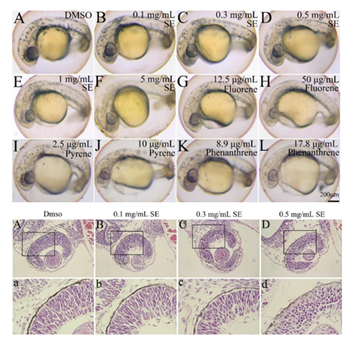Reduced pigmentation and thyroid hormone disruption in zebrafish embryos caused by industrial sludge near Bohai Bay, China
Published 14 July, 2023
Bohai Bay, located in China, is a representative semi-closed bay. Over the past few years, the land encompassing Bohai Bay has undergone rapid industrialization, making it one of China's most densely populated and industrially developed regions. The presence of various industries, including crude oil production, chemical manufacturing, rubber processing, and steel production, has contributed to the pollution levels in the surrounding environment.
Unfortunately, these pollutants have the potential to jeopardize both the marine ecosystem of Bohai Bay and the well-being of the coastal residents. Efforts need to be made to address this pressing issue and mitigate the adverse effects on both the environment and the local population.
To that end, a team of researchers in the country investigated the sludge collected from the outlet of a factory, which discharges effluent into Bohai Bay. They prepared alcohol extracts of the sludge and performed ultra performance liquid chromatography-tandem mass spectrometry (UPLC-MS/MS) analysis. Through this analysis, they identified the presence of polycyclic aromatic hydrocarbons (PAHs) such as fluorene, phenanthrene and pyrene in the sediment of the sludge.
“To assess the potential impact of the sediment on zebrafish development, we used zebrafish embryos as an animal model,” shared Wenjing Dong, lead author of the study. “Our evaluations encompassed multiple aspects, including morphological observations, behavioral assessments, histological examinations, and genetic analyses.”
These comprehensive evaluations allowed the researchers to gain insights into the effects of the sediment on various levels of zebrafish development. The results revealed that the sediment caused concentration-dependent mortality and decreased hatchability. It inhibited pigmentation, reduced swimming distance, and lowered triiodothyronine (T3) levels. Thyroid hormone-related genes were downregulated (TPO, Thrβ), while Dio2 and Dio3 were upregulated. Individual PAHs induced similar effects as sediment exposure.
The team’s findings are published in the KeAi journal Water Biology and Security.
“This study highlights the negative impact of PAHs present in sediment on zebrafish pigmentation, likely due to genetic alterations related to thyroid hormones. In addition to chemical monitoring, biomonitoring endpoints such as pigmentation, behavioral changes, and gene expression can serve as valuable indicators to predict and assess PAH pollution in Bohai Bay,” added Dong.
Image:

Figure1. SE significantly reduced eye pigmentation
Contact author name, affiliation, email address: Wu Dong, dongwu@imun.edu.cn; Tel.: +86-475-831-4845, College of Animal Science and Technology, Inner Mongolia Minzu University/Inner Mongolia Key Laboratory of Toxicant Monitoring and Toxicology, Tongliao, 028000, China.
Funder: This study was funded by the National Natural Science Foundation of China (82060672), the Program for Interdisciplinary Innovation team in Inner Mongolia Minzu University, China (Dongwu-2023), and the Natural Science Foundation of Inner Mongolia Autonomous Region of China (2020MS08103).
See the article: Wenjing Dong, Xiaoyu Yin, Chelimuge Qi, Tingting Wei, Lijia Wei, Jingfeng Yang, Jingli Mu, Hiroki Teraoka, Wu Dong, Reduced pigmentation and thyroid hormone disruption in zebrafish embryos caused by industrial sludge near Bohai Bay, China, Water Biology and Security, 2023, 100190, ISSN 2772-7351, https://doi.org/10.1016/j.watbs.2023.100190.